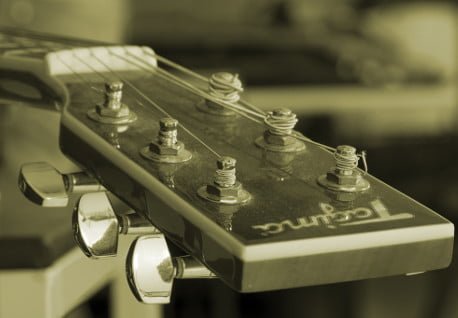Table of Contents
“How often should you change your guitar strings?” is a question that many guitarists, both novice and experienced, frequently ask. Regularly replacing strings is crucial for maintaining optimal sound quality and playability.
This Killer Rig guide provides comprehensive information on the significance of fresh guitar strings, factors affecting their lifespan, and guidelines for timely replacement.
By understanding and adhering to these principles, one can ensure the best performance from their instrument and prolong its longevity.
String Change Summary
- Infrequent Player:
- Change strings once a year if playing less than 15 minutes per week.
- Occasional Dabbler or Learner:
- Change strings every 6-8 months if playing 1-3 hours per week.
- Avid Hobbyist:
- Change strings every 3-5 months if playing 3-12 hours per week.
- Serious Player or Aspiring Pro:
- Change strings every 1-2 months if playing 12-25 hours per week.
- Pro Musician:
- Change strings once a week or possibly daily if playing 30+ hours per week.
Why Changing Guitar Strings is Essential
Changing guitar strings is not merely a routine maintenance task; it’s fundamental for several reasons:
- Sound Quality: Fresh strings provide a clear, bright, and resonant sound. As strings age, they lose their tonal quality, leading to a dull and muted sound.
- Playability: New strings are more responsive to touch, making it easier to play, slide, and bend notes. Worn-out strings can become rough or uneven, causing discomfort and reducing playability.
- Tuning Stability: Old strings have a tendency to go out of tune more frequently. Changing strings ensures that the guitar remains in tune for longer durations, providing a consistent sound.
- Instrument Health: Strings are under constant tension. Over time, corroded or damaged strings can exert uneven pressure on the guitar’s neck. Regularly changing them ensures that the tension remains balanced, protecting the instrument’s structural integrity.
- Aesthetic Appeal: Fresh strings have a shiny and clean appearance, enhancing the overall look of the guitar. Rusty or discolored strings can detract from the instrument’s visual appeal.
- Avoiding Breakage: Strings weaken over time due to wear and tear. Regularly changing them reduces the risk of unexpected breakages, which can be inconvenient during performances or practice sessions.
Regularly changing guitar strings is crucial for maintaining the instrument’s sound quality, playability, and overall health. It’s an investment in the longevity and performance of the guitar.

How Often Should You Change Your Guitar Strings?
The frequency with which you should change your guitar strings largely depends on your playing habits, the environmental conditions where you store your instrument, and your preferences regarding sound quality.
Strings undergo wear and tear not just from playing, but also from factors like sweat, oils, and atmospheric conditions. Over time, this can lead to a loss of tonal quality, reduced playability, and even potential damage to your guitar.
Factors to Consider:
- Playing Frequency: The more you play, the more stress and wear you put on your strings. This can lead to a faster degradation of sound quality.
- Playing Style: Aggressive strumming or bending can wear out strings faster than gentle playing.
- Environmental Conditions: Strings can corrode faster in humid or salty environments. If you live near the coast or in a place with high humidity, you might need to change your strings more often.
- Body Chemistry: Some people have acidic sweat that can corrode strings faster.
- String Type: Coated strings, while often more expensive, can last longer than uncoated options.
Recommended String Change Frequency Based on Playing Habits:
| Player Type | Playing Frequency | Recommended String Change |
|---|---|---|
| Infrequent Player | Less than 15 minutes/week | Once a year |
| Dabbler/Learner | 1-3 hours/week | Every 6-8 months |
| Hobbyist | 3-12 hours/week | Every 3-5 months |
| Serious Player | 12-25 hours/week | Every 1-2 months |
| Professional Musician | 30+ hours/week | Once a week or daily |
It’s essential to note that these are general guidelines. The best indicator is always your personal experience. If you feel a decline in sound quality, experience tuning instability, or see visible signs of wear or rust on your strings, it’s probably time for a change.
Regularly inspecting and listening to your strings can help you determine the optimal change frequency for your specific circumstances.
Signs It’s Time to Change Your Strings
Recognizing when to change your guitar strings is crucial for maintaining the instrument’s optimal performance.
While the frequency of play and environmental conditions play a role, there are specific signs that indicate your strings are past their prime. Here are some clear indicators that it’s time for a fresh set:
- Loss of Tonal Quality. If your guitar starts sounding dull, flat, or lacks the bright resonance it once had, it’s a clear sign the strings are worn out.
- Difficulty in Tuning. Strings that have lost their elasticity and integrity will have trouble staying in tune. If you find yourself constantly retuning, consider changing your strings.
- Visible Discoloration or Rust. Over time, strings can oxidize, leading to rust and discoloration. If you notice any brown or rusty spots, it’s time for a replacement.
- Rough Texture. As strings age, they can develop small indentations and rough spots, especially where they make contact with the frets. If you can feel these rough areas when you slide your fingers along the strings, they’re likely due for a change.
- Decreased Playability. If the strings feel harder to press down or if they don’t produce a clear sound when played, they might be too old.
- Frequent String Breakage. While occasional string breakage can happen for various reasons, if you notice your strings are breaking more frequently, it’s a sign that they’re weakened and old.
- Lack of Vibrancy. New strings have a certain “ring” or “brightness” to them. If your strings sound muted or lack vibrancy, even after cleaning, they’re likely worn out.
- Corroded or Flattened Winding. Upon close inspection, if the winding on the strings appears to be flattened in areas where they contact the frets or if there’s visible corrosion, it’s time to replace them.
- String Slippage. If the strings are slipping out of tune frequently, especially after bending them, it indicates a loss of tension and integrity.
- Age. Even if you don’t play your guitar often, strings can degrade over time simply due to exposure to air and environmental factors. If it’s been many months or even a year since you last changed them, consider a fresh set.

Extending Guitar String Life
Once you get your strings to the point that you like, you can extend their life with simple tasks. Most guitar players overlook these things, but they can make a big difference. And if you can extend their life, you can enjoy their sound longer.
So we suggest that you add these tasks to your guitar practice routine at the very least.
Wash Your Hands
Washing your hands before you play is a great way to keep dirt and oils from building up on the strings. Your fingers will transfer a great deal of grime, which eventually dulls them. This is an easy way to extend their life span.
Some players say that the oil helps their fingers glide on the strings, so they prefer not to wash them. This may be your preference as well, and that is fine. But consider that your finger calluses do most of that heavy lifting, and not the oil from your fingers.
Adjust Your Play Style
If you play pretty aggressively, then your strings will wear out sooner. A lot of bending, hard strumming, or whammy bar action will result in wear. If you are easier on them, then this isn’t something you need to consider.
What you will notice with a more aggressive play style is that the strings will break or be hard to keep tuned up. If you are not able to adjust your play style, then make sure to be using the right strings. This means you need to account for thickness and material.
Environment
Another thing to consider is the environment in which your guitar spends most of its time. For steel strings, this is a bigger deal than nylon and is worth considering.
If the environment is humid or damp, chances are they will rust just sitting there. This will dictate how often you should change your guitar strings. It’s usually a good idea to verify that your environment is good for the instrument itself as well.
Some environments will even damage a guitar. It’s worth considering where the instrument is most of the time.
Clean Your Strings After You Play
If you have ever wiped your strings down at any point, you know how dirty they get. This dirt can be prevented by cleaning after you play. Even if it’s one cleaning a week, this can help give them a longer life.
At the very least, you may find they get some note sustain back as the dirt is removed. This can be done using a rag and just giving them a good wipe-down. There are also products on the market that make this a breeze.

Recommended Strings
There are many guitar string brands on the market today. When asking how often should you change your guitar strings, you have to know what is best. Not every set is created equal.
Some are great, while others are not, and you get what you pay for. If you have already found your brand and love them to pieces, that’s great!
If you are newer to the instrument and are not sure what is good, we have a few suggestions for you. These are the brands that have created a name for themselves because of their quality. They are also the string brands I use on my guitars and find them to be the best.
Electric Strings:
Acoustic Strings:
Nylon:

Conclusion
Maintaining the sound and playability of your guitar requires routine string care. It’s critical to consider the elements that influence the longevity of your strings.
Know when it’s time to change them by the signs. Likewise, stick to the usual string replacement guidelines. Then you can ensure that your guitar stays in top condition.
Each player’s string replacement schedule will differ. This is based on their playing habits, environment, and personal preferences. Stay attentive to your guitar’s sound and feel. You can then develop a personalized schedule.

